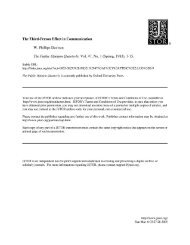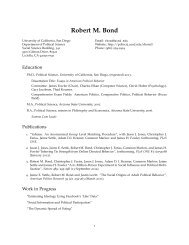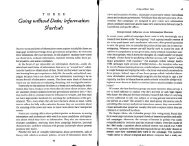Chapter 6 Why Authoritarian Parties? The Regime Party as an ...
Chapter 6 Why Authoritarian Parties? The Regime Party as an ...
Chapter 6 Why Authoritarian Parties? The Regime Party as an ...
Create successful ePaper yourself
Turn your PDF publications into a flip-book with our unique Google optimized e-Paper software.
CHAPTER 6<br />
<strong>an</strong>d outside of authoritari<strong>an</strong> parties (see e.g. Bratton <strong>an</strong>d V<strong>an</strong> de Walle 1997; Kitschelt <strong>an</strong>d<br />
Wilkinson 2007; V<strong>an</strong> de Walle 2001). What makes authoritari<strong>an</strong> parties such particularly<br />
apt vehicles for the cooptation of the m<strong>as</strong>ses?<br />
According to <strong>an</strong>other prominent view, authoritari<strong>an</strong> parties facilitate cooperation <strong>an</strong>d<br />
prevent factionalism among the regime’s elites (Brownlee 2007; Geddes 1999b; Magaloni<br />
2006). According to Geddes (1999b; 2003), for inst<strong>an</strong>ce, in single-party regimes “everyone is<br />
better off if all factions remain united <strong>an</strong>d in office” (Geddes 2003, 59). Arguably, however,<br />
incentives to “stick together or h<strong>an</strong>g separately” – to paraphr<strong>as</strong>e Benjamin Fr<strong>an</strong>klin – gener-<br />
ically exist in most dictatorships. What is the mech<strong>an</strong>ism by which authoritari<strong>an</strong> parties so<br />
uniquely maintain elite cohesion?<br />
In this chapter, I attempt to adv<strong>an</strong>ce existing research onthe roleof parties inauthoritar-<br />
i<strong>an</strong>govern<strong>an</strong>cebydeveloping argumentsthatexplaini)how<strong>an</strong>dwhichspecificorg<strong>an</strong>izational<br />
features of authoritari<strong>an</strong> parties contribute to authoritari<strong>an</strong> resilience, ii) why these benefi-<br />
cial functions could not be carried out without the institution of the party, <strong>an</strong>d iii) why some<br />
dictatorships establish <strong>an</strong>d maintain a regime-s<strong>an</strong>ctioned party while others do not.<br />
I identify three org<strong>an</strong>izational features of successful authoritari<strong>an</strong>parties that account for<br />
the effectiveness of parties <strong>as</strong> instruments of authoritari<strong>an</strong> cooptation, both at the m<strong>as</strong>s <strong>an</strong>d<br />
elite level. <strong>The</strong>se features are hierarchical <strong>as</strong>signment of service <strong>an</strong>d benefits, political control<br />
over appointments, <strong>an</strong>d selective recruitment <strong>an</strong>d repression. Crucially, these features of in-<br />
ternal party org<strong>an</strong>ization accomplish much more th<strong>an</strong> simply distribute rewards in exch<strong>an</strong>ge<br />
for party members’ support of the regime, <strong>as</strong> the existing literature often concludes. Rather<br />
th<strong>an</strong> fora for political exch<strong>an</strong>ge, authoritari<strong>an</strong> parties are better thought of <strong>as</strong> institutional-<br />
ized incentive structures that encourage sunk political investment by their members, which<br />
3











